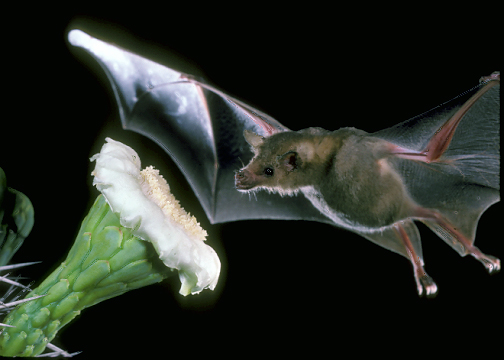A basic understanding of bat biology, reproduction, habitat, and behavior can help school district officials prevent or manage bat problems most effectively, at the lowest cost, and with the least harm to the bats.

A lesser long-nosed bat pollinating a saguaro cactus. (Copyright photo by Merlin D. Tuttle, Bat Conservation International, www.batcon.org)
Bats are highly beneficial native mammals:
- Some bat species eat insects and consume up to their weight in food each night. A colony of bats can eat literally tons of insects every night. Bats also consume insects that damage crops. Research has shown that free-tailed bats in South Central Texas may save farmers up to $1.7 million a year by consuming significant numbers of agricultural pests.
- Other bats feed on nectar and are important pollinators, especially in rainforests.
- Some bats feed on fruits and disperse the seeds. More than 300 species of fruits depend on bats for pollination or seed dispersal; fruits pollinated by bats include avocadoes, bananas, carob, figs, mangoes, and peaches.
- Bats serve as food for owls, hawks, falcons, opossums, and raccoons.
- Bat waste, which is called guano, can be used as fertilizer.
Despite popular belief, bats are not flying rodents; they belong to an order of mammals called Chiroptera (Latin for hand wing). Like all mammals, bats produce milk to nurse their young (pups). Although most bat species produce one pup a year, a few species give birth to litters of two to four pups.Some bat species mate in the fall or winter, but fertilization is delayed and the fetus does not develop until spring. Other species, such as the Mexican free-tailed bat, mate in the spring, and their pups are born in the spring or early summer. By late summer, the pups can fly and feed on their own. The period from the pups’ birth to their ability to fly is called the maternity season.
Bats live in a variety of places, including under tree bark and in caves, tree cavities, hollow trees, palm fronds, abandoned mines, and crevices under bridges. Some species also commonly roost in buildings. Bats are creatures of habit and will return to the same roost for many years.
Of the 33 species of bats known to live in Texas, 11 can live near humans and transmit rabies.
Six species of colonial bats are known to occupy structures in Texas:
- Big brown bat (Eptesicus fuscus)
- Cave myotis (Myotis velifer)
- Eastern pipistrelle or tri-colored bat (Pipostrellus subflavu)
- Evening bat (Nycticeius humeralis)
- Mexican free-tailed bat (Tadarida brasiliensis; subspecies: T. b. Mexicana and T. b. cynocephala)
- Southeastern myotis (Myotis austroriparius)
Four species of solitary bats have roosted in buildings in Texas:
- Eastern red bat (Lasiurus borealis)
- Hoary bat (Lasiurus cinereus)
- Northern yellow bat (Lasiurus intermedius, southern yellow bat (Lasiurus ega)
- Seminole bat (Lasiurus seminolus)